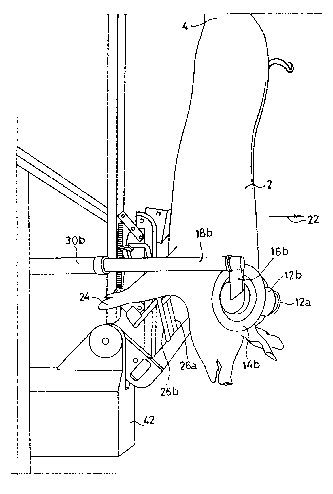Une partie des informations de ce site Web a été fournie par des sources externes. Le gouvernement du Canada n'assume aucune responsabilité concernant la précision, l'actualité ou la fiabilité des informations fournies par les sources externes. Les utilisateurs qui désirent employer cette information devraient consulter directement la source des informations. Le contenu fourni par les sources externes n'est pas assujetti aux exigences sur les langues officielles, la protection des renseignements personnels et l'accessibilité.
L'apparition de différences dans le texte et l'image des Revendications et de l'Abrégé dépend du moment auquel le document est publié. Les textes des Revendications et de l'Abrégé sont affichés :
| (12) Demande de brevet: | (11) CA 2042729 |
|---|---|
| (54) Titre français: | APPAREIL PERMETTANT DE PRATIQUER UNE OUVERTURE DANS LA POITRINE ET L'ABDOMEN D'UNE CARCASSE D'ANIMAL DE BOUCHERIE |
| (54) Titre anglais: | DEVICE FOR FORMING A CUT IN BREAST AND BELLY OF A SLAUGHTERED ANIMAL CARCASS |
| Statut: | Réputée abandonnée et au-delà du délai pour le rétablissement - en attente de la réponse à l’avis de communication rejetée |
| (51) Classification internationale des brevets (CIB): |
|
|---|---|
| (72) Inventeurs : |
|
| (73) Titulaires : |
|
| (71) Demandeurs : |
|
| (74) Agent: | KENT & EDGARKENT & EDGAR, |
| (74) Co-agent: | |
| (45) Délivré: | |
| (22) Date de dépôt: | 1991-05-16 |
| (41) Mise à la disponibilité du public: | 1991-11-18 |
| Licence disponible: | S.O. |
| Cédé au domaine public: | S.O. |
| (25) Langue des documents déposés: | Anglais |
| Traité de coopération en matière de brevets (PCT): | Non |
|---|
| (30) Données de priorité de la demande: | ||||||
|---|---|---|---|---|---|---|
|
ABSTRACT OF THE DISCLOSURE
Device for forming a cut in breast and belly of a slaughtered
animal carcass.
Device for forming a cut in breast and belly of the carcass
of a slaughtered animal comprising a mandrel, a cutting blade
and two pressure rollers lying on either side of the mandrel
engaging the rear side of the carcass near the head, each
roller being fitted at the first end of an arm which at the
other end is connected to a carrier situated beside the
mandrel and extendable in the direction of the carcass, which
arms can each be swung about the longitudinal axis of the
carrier the roller being provided with a disc-shaped flange
right angles to the roller axis.
Note : Les revendications sont présentées dans la langue officielle dans laquelle elles ont été soumises.
Note : Les descriptions sont présentées dans la langue officielle dans laquelle elles ont été soumises.

2024-08-01 : Dans le cadre de la transition vers les Brevets de nouvelle génération (BNG), la base de données sur les brevets canadiens (BDBC) contient désormais un Historique d'événement plus détaillé, qui reproduit le Journal des événements de notre nouvelle solution interne.
Veuillez noter que les événements débutant par « Inactive : » se réfèrent à des événements qui ne sont plus utilisés dans notre nouvelle solution interne.
Pour une meilleure compréhension de l'état de la demande ou brevet qui figure sur cette page, la rubrique Mise en garde , et les descriptions de Brevet , Historique d'événement , Taxes périodiques et Historique des paiements devraient être consultées.
| Description | Date |
|---|---|
| Inactive : CIB de MCD | 2006-03-11 |
| Le délai pour l'annulation est expiré | 1995-11-16 |
| Demande non rétablie avant l'échéance | 1995-11-16 |
| Réputée abandonnée - omission de répondre à un avis sur les taxes pour le maintien en état | 1995-05-16 |
| Inactive : Demande ad hoc documentée | 1995-05-16 |
| Demande publiée (accessible au public) | 1991-11-18 |
| Date d'abandonnement | Raison | Date de rétablissement |
|---|---|---|
| 1995-05-16 |
Les titulaires actuels et antérieures au dossier sont affichés en ordre alphabétique.
| Titulaires actuels au dossier |
|---|
| MARINUS F. L. BEKKERS |
| C.C.M BEHEER B.V. |
| Titulaires antérieures au dossier |
|---|
| S.O. |